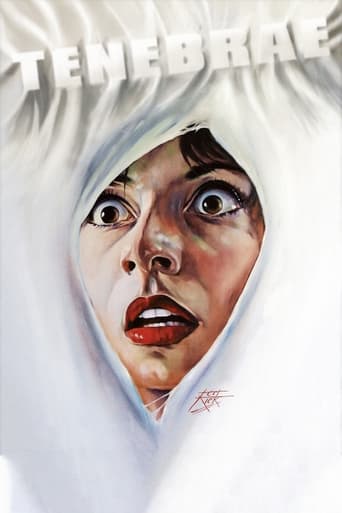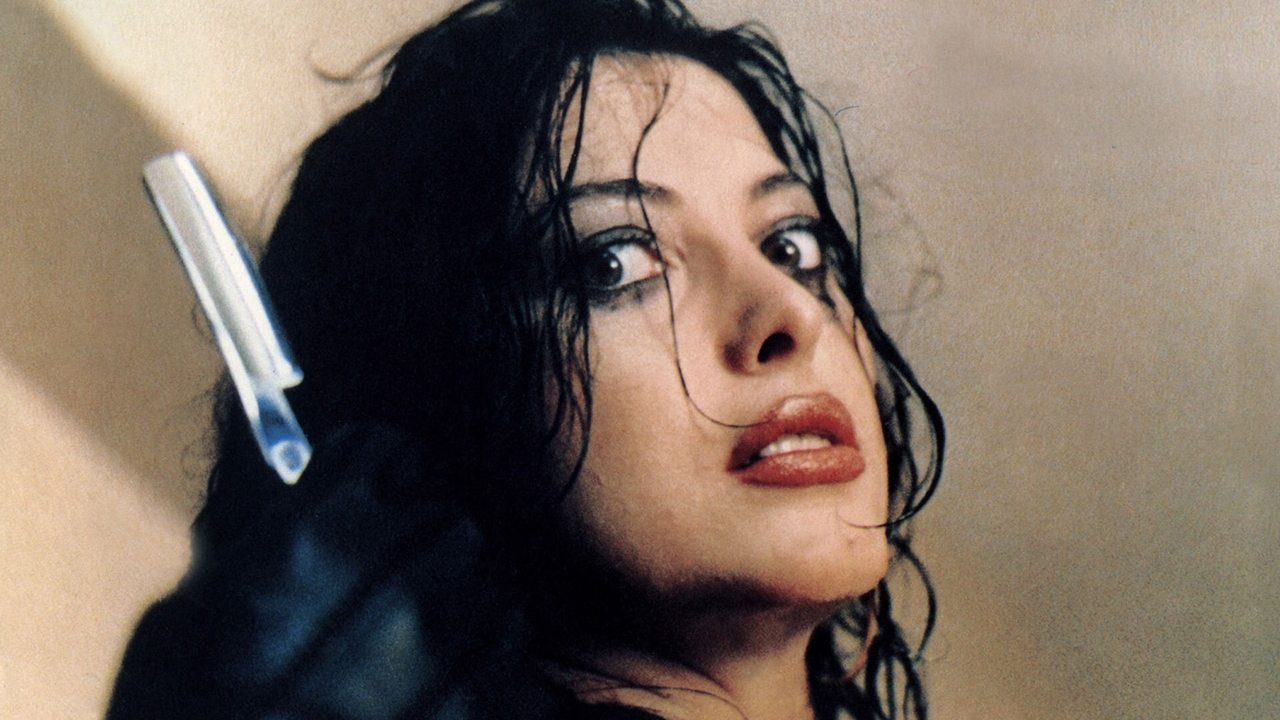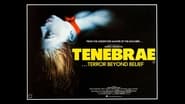bombersflyup
Tenebre is a low quality foreign slasher type joke of a film, but has its entertainment value.The story and the acting are quite simply a zero score out of whatever scale you want to use and the murder scenes are extremely poor. It is basically a showcase of beautiful braless women, silly music and various locations and camera angles. Lara Wendel was particularly nice as Maria and I found myself amused enough not to trash the film completely. Though the many reviews of actual praise in film making, are absurd. Style no problem, thrilling mystery, gripping story and suspense, you've got to be kidding.
grahamcarter-1
The Christian religious service of 'Tenebrae' involves the gradual extinguishing of candles, while a series of readings and psalms is recited; Matins and Lauds.In 'Tenebre', there are two separate characters who suffer from impaired vision. Detective Giermani tells writer Peter Neal that he is a big fan of "Agatha Chrisite, Spillane and Ed McBain
" however he goes on to reveal that he has never been able to solve the identity of the killer in any of their stories. This continues into real life as the corpses pile up with Neal standing in plain sight. Neal with a traumatic event in his youth hinted at, responds to a series of murders by becoming a killer himself. He introduces the theme of impaired vision when he admits to Giermani: "I've tried to figure it out, but I just have this hunch that something is missing, a tiny piece of the jigsaw. Somebody who should be dead is alive, or somebody who should be alive is already dead." Of course Neal, who is promoting his latest book 'Tenebrae,' is the 'missing piece,' and in the end he will become the 'somebody who should be dead.' In flashback a sadistic temptress is stabbed to death; this acts as the catalyst for the murders in the film. In the present day, the first victim is a sexually promiscuous shoplifter, and the next two are the lesbian reporter and her bisexual lover. The flashbacks are introduced repeatedly throughout the course of the film, usually immediately following a murder. The first reveals a beautiful young woman's sexual bullying of a teenage boy (whom we later presume is Neal). The second is a revenge-murder of the same woman. There is a doubling between Neal and Giermani, as Giermani reflects Neal even as Neal takes on his role as investigator. The detective/writer and the writer/detective each belittle the other. In what is one of the best pieces of 'shock' ever put on celluloid, Neal and Giermani become one (momentarily) when Neal memorably dispatches the Detective; "in a shot that is as schematically logical as it is logically outrageous" (McDonagh). The reveal of the killer as the hero bends down was borrowed from Argento's own 'The Bird with the Crystal Plumage', as is the climactic murder by art in which Dalmas was trapped beneath a large pointed sculpture.Although 'tenebrae'/'tenebre' means 'darkness' or 'shadows,' Argento tasked his cinematographer Luciano Tavoli with filling the screen with as much light as possible. Tavoli had worked on 'Suspiria', and had also worked with Antonioni on 'Chung Kuo-China' (1972), 'The Passenger' (1975), and the first feature shot on video 'The Mystery of Oberwald' (1981). The day scenes are brightly lit, and the interiors harshly over lit; the film is shot with clear 'cold' light, permeating the surroundings. He was deliberately breaking with the legacy of German Expressionism.Fritz Lang's Beyond a Reasonable Doubt (1956) comes to mind when considering Argento's influences; film-noir at its most paranoid often finds Lang not far away. '
doubt' finds a man convicted of murder on false evidence who in fact is guilty of the crime. Roy William Neill's legendary film- noir Black Angel (1946) is even more remarkable, where a man tries to clear a murder suspect, but doing so will be at the cost of learning that he himself is the killer. An argument could be made for 'Tenebre' being one of the most important 'non-Hitchcock' films De Palma has seen; the 'Louma' crane sequence is clearly a key influence right down to the music in 'The Untouchables' (1987). More obvious still is the 'Raising Cain' surprise reveal of the killer standing behind the victim. Robert Zemeckis' 'What Lies Beneath' (2000) contains a similar moment, although Zemeckis has denied having any familiarity at all with Italian 'Giallo'
more's the pity.Successful and released without incident in Europe, 'Tenebre' was classified, prosecuted and banned as a 'video nasty' in the U.K, and the film had five minutes of 'sexualised violence' cut prior to its theatrical release. Its U.S distribution was delayed for two years, then only in a heavily censored version under the title 'Unsane.' Approximately ten minutes shorter, losing scenes that established the characters and their relationships that make it difficult to follow, it received a mostly negative critical reception.Critic and Argento expert Maitland McDonagh has described 'Tenebre' (as opposed to 'Unsane'), as "the finest film that Argento has ever made."
CinemaClown
From the writer-director of Deep Red & Suspiria, Tenebre (also known as Tenebrae) marks Dario Argento's return to the very subgenre of horror he does better than anyone else and presents the filmmaker at the top of his game. Stylishly directed, dipped in blood-soaked violence and keeping its mystery alive until the very end, it remains one of the finest works of his filmmaking career.The story of Tenebre follows an American author who arrives in Rome to promote his latest murder mystery novel, only to find that his book may have inspired a serial killer to go on a killing spree. As the body count start going up with no suspect in sight, he provides full cooperation to the police to apprehend the killer at large but becomes far more embroiled in the case than he anticipated.Written & directed by Dario Argento, Tenebre is riveting from its opening moments and makes fab use of all his trademarks & visual flair. Goblin's score once again drives majority of the events that transpire in the film and expertly sets the mood as per the requirements of the scene. Argento's direction also exudes a high level of comfort, for giallo horrors have always been his playground.The overcast conditions & cold surroundings encapsulate the film with an eerie ambiance which is then all the more amplified by its vibrant camera-work, stark colour palette & Goblin's sinister score. Cinematography is a definite highlight, for the vivid manner in which its camera is utilised in many segments not only heightens the viewers' senses but also intensifies the desired impact of those moments.Rome has never looked as desolate as it looks in this picture, for all the city landmarks & crowded locations are stripped away from the final print. Editing is brilliantly carried out, the twists n turns keep surfacing at regular intervals, plus the plot manages to stay ahead of its viewers at all times. And despite its over-the-top violence & ketchup-laden make-up, it remains one of Argento's most violence flicks to date.Coming to the performances, the cast comprises of Anthony Franciosa, Daria Nicolodi, John Saxon & Giuliano Gemma, with Franciosa impressing the most. Carrying the entire film on his shoulders, Franciosa does enough to make his character likable, Nicolodi does well for the most part but she goes absolutely bonkers in the final moments, Gemma does well with what he's given while Saxon is the weak link here, surprisingly.On an overall scale, Tenebre is a skilfully crafted, cleverly narrated & unabashedly violent example of giallo horror that not only finishes as one of Dario Argento's best films to date but also ranks as one of the greatest works of giallo horror. Brimming with multitudes of themes, riddled with twists on every corner & jam-packed with brutal killings, each more savage than the last one, Tenebre is as thrilling as it is barbaric and features a finale that no one saw coming. Definitely worth a shot.
tieman64
"Just torture and murder: No character, no plot—I think it's the future." - Videodrome Dario Argento's "Tenebrae" stars Anthony Franciosca as Peter Neal, an American writer of crime fiction. When he journeys to Rome, Neal is startled to discover that someone is committing crimes modelled on the murders Neal has himself staged in print. This killer deems his victims "corrupt perverts" who must be "wiped away".Several self-reflexive moments then occur, Argento mockingly aligning his own perversions with those seen on screen (it is Argento's hands we see committing the film's various crimes). "Why do you despise women so much?" one character then asks, referring to the accusations of sexism oft hurled at Argento. The film then reveals its big twist: it is a sanctimonious art critic who is responsible for the film's murders. This critic, who masks his own hate and bigotry with attacks on Neal's art, then becomes Argento's attack on those who disparage him: I'm not sexist or a homophone, Argento essentially says, you're projecting your own peculiarities onto me! If the film ended here, Argento's self-defence would be silly. But it doesn't, and the film goes on to reveal that there are in fact two murders, one an art critic and one Neal himself. The hate which spurs both killers, then, lies on both sides of the divide: critic and artist, spectator and artwork, screen and audience.The second half of the film then attempts to locate the "cause" of "Tenebrae's" murders. In the critic's case, the killings are spurred by a kind of hard-lined conservatism, mixed with a little influence from Neal's books (one of which is also called "Tenebrae"). In Neal's case, it is proximity to the critic's murders which awakens in Neal a dormant psychosis. But what initially caused this psychosis? Neal was once turned down by a young woman, an incident which pushed him into essentially becoming a sexist murderer (he would later kill his adulterous wife). The film then ends with Neal literally being killed by a "work of art", an incident which complicates arguments made by characters at the start of the film; art is not only something passive, but something capable of influence. It has the power to murder, either by design, or, as Argento's final killing shows, by sheer accident.This "accidental" aspect is stressed by the film. It is sheer arbitrariness which makes someone a victim or killer, regardless of irresponsibility on the part of the spectator or artist. The critic is bigoted regardless of whether or not he appropriates Neal's art, and Neal's art is sexist because he is sexist, he's not sexist because of his art. Other scenes, which show men dying to high heeled shoes, and portray men lusting after and then being assaulted by transsexuals (Roberto Coatti), blur the lines between gender, sexual privilege and sexually based hate. In "Tenebre", everyone is simultaneously suspect, victim and murderer, and everyone holds the potential to be either killer or victim. Indeed, most of the film's killings are preceded by a scene in which another character could have theoretically committed the crime were it allowed to. The end result is a film in which Argento concedes that his critics are absolutely right, but also one which functions as an apologia or rebuttal.Aesthetically, "Tenebrae" is one of Argento's weaker films. Its bravura sequences are few and far between, only one sequence is architecturally interesting, and the film's killings dip too far into blood-porn. "Tenebrae" ends with a shot which would be stolen by Brian De Palma's "Raising Caine", and contains a razor-blade killing borrowed from De Palma's "Dressed to Kill", released two years earlier.7/10 - Worth two viewings.


 AD
AD













